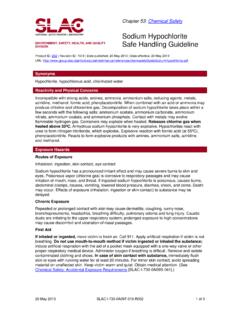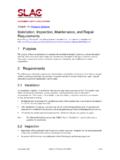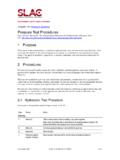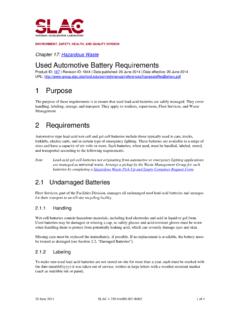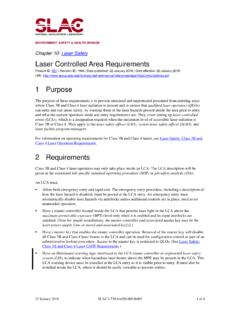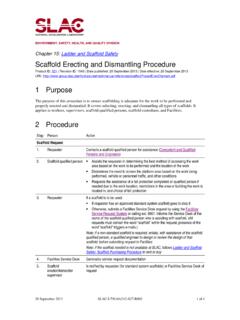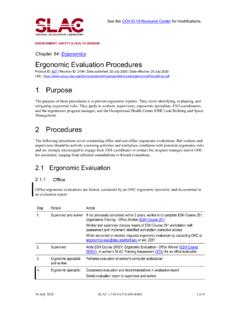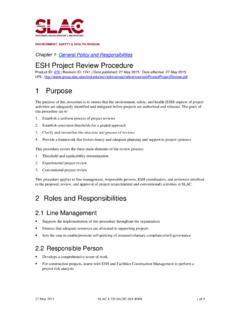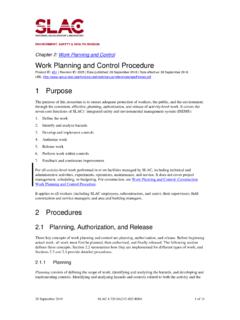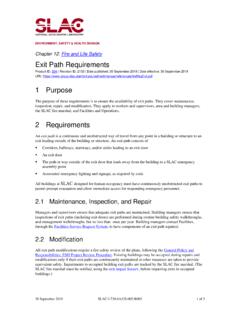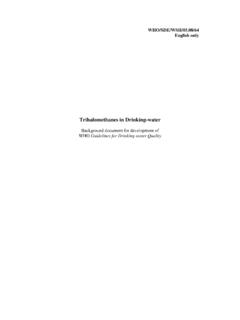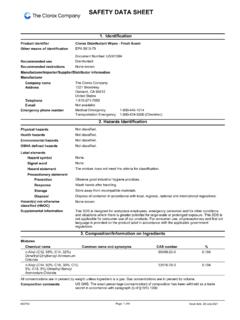Transcription of Sodium Hypochlorite ENVIRONMENT, SAFETY, HEALTH, AND ...
1 ENVIRONMENT, SAFETY, HEALTH, AND QUALITY DIVISION Chapter 53: Chemical Safety Sodium Hypochlorite Safe Handling Guideline Product ID: 202 | Revision ID: 1513 | Date published: 20 May 2013 | Date effective: 20 May 2013 URL: 20 May 2013 SLAC-I -730-0A09T-016-R002 1 of 3 Synonyms Hypochlorite , hypochlorous acid, chlorinated water Reactivity and Physical Concerns Incompatible with strong acids, amines, ammonia, ammonium salts, reducing agents, metals, aziridine, methanol, formic acid, phenylacetonitrile. When combined with an acid or ammonia may produce chlorine and chloramine gas.
2 Decomposition of Sodium Hypochlorite takes place within a few seconds with the following salts: ammonium acetate, ammonium carbonate, ammonium nitrate, ammonium oxalate, and ammonium phosphate. Contact with metals may evolve flammable hydrogen gas. Containers may explode when heated. Releases chlorine gas when heated above 35 C. Anhydrous Sodium Hypochlorite is very explosive. Hypochlorites react with urea to form nitrogen trichloride, which explodes. Explosive reaction with formic acid (at 55 C), phenylacetonitrile. Reacts to form explosive products with amines, ammonium salts, aziridine, and methanol.
3 Exposure Hazards Routes of Exposure Inhalation, ingestion, skin contact, eye contact Sodium Hypochlorite has a pronounced irritant effect and may cause severe burns to skin and eyes. Poisonous vapor ( chlorine gas) is corrosive to respiratory passages and may cause irritation of mouth, nose, and throat. If ingested Sodium Hypochlorite is poisonous, causes burns, abdominal cramps, nausea, vomiting, lowered blood pressure, diarrhea, shock, and coma. Death may occur. Effects of exposure (inhalation, ingestion or skin contact) to substance may be delayed. Chronic Exposure Repeated or prolonged contact with skin may cause dermatitis, coughing, runny nose, bronchopneumonia, headaches, breathing difficulty, pulmonary edema and lung injury.
4 Caustic dusts are irritating to the upper respiratory system; prolonged exposure to high concentrations may cause discomfort and ulceration of nasal passages. First Aid If inhaled or ingested, move victim to fresh air. Call 911. Apply artificial respiration if victim is not breathing. Do not use mouth-to-mouth method if victim ingested or inhaled the substance; induce artificial respiration with the aid of a pocket mask equipped with a one-way valve or other proper respiratory medical device. Administer oxygen if breathing is difficult. Remove and isolate contaminated clothing and shoes.
5 In case of skin contact with substance, immediately flush skin or eyes with running water for at least 20 minutes. For minor skin contact, avoid spreading material on unaffected skin. Keep victim warm and quiet. Obtain medical attention. (See Chemical Safety: Accidental Exposure Requirements [SLAC-I-730-0A09S-041].) SLAC National Accelerator Laboratory Environment, Safety, Health, and Quality Division Chapter 53 | Sodium Hypochlorite Safe Handling Guideline 20 May 2013 SLAC-I -730-0A09T-016-R002 2 of 3 Exposure Limits Permissible exposure limit: not established NIOSH recommended exposure limit: not established Immediately dangerous to life and health: not established Exposure Controls Engineering Controls Local exhaust ventilation or breathing protection is required.
6 Secondary containment of all storage and use is required. Administrative Controls Procedures should be developed for the safe use and handling of Sodium Hypochlorite in all applications. ESHQ can provide information and guidance. Depending upon quantities, certain regulatory permits and/or registrations may be required. Personnel working with the materials must receive detailed training on the hazards, safe use, and emergency procedures Personal Protective Equipment Avoid bodily contact with the material. Contact lenses should not be worn while working with this substance.
7 Prevent skin/eye contact through the use of impervious gloves, clothing, boots, apron, and eye goggles or full face shield. Avoid breathing vapors. If the airborne exposure limit may be exceeded and engineering controls are not feasible, wear a NIOSH-approved self-contained breathing apparatus with full face-piece operated in the pressure demand or other positive pressure mode. Disposal Material is disposed of as hazardous waste. Contact the Waste Management Group for specific disposal requirements and procedures. Containers and other materials that are contaminated must also be treated as hazardous waste.
8 Medical Monitoring (if applicable) NA Emergency Response In the event of a spill that poses a threat to health and/or the environment, immediately evacuate the area and call 911. Then call SLAC Site Security (ext. 5555 or 650-926-5555 from a cell phone) and notify your supervisor. For other spills, notify your supervisor then SLAC Site Security; these may be cleaned up with appropriate spill response supplies by trained personnel who have been authorized via work planning and control. (See Spills: Response, Cleanup, and Reporting Procedure [SLAC-I-750-0A16C-006].)
9 Standards and Regulations OSHA. PEL: 29 CFR Table Z-1; Respiratory Protection: 29 CFR EPA. Release: 40 CFR ; Waste: 40 CFR California Fire Code, Chapters 27 through 41 (24 CCR Part 9) Other References NLM. TOXNET: Toxicology Data Network SLAC National Accelerator Laboratory Environment, Safety, Health, and Quality Division Chapter 53 | Sodium Hypochlorite Safe Handling Guideline 20 May 2013 SLAC-I -730-0A09T-016-R002 3 of 3 NIOSH. International Chemical Safety Card: Sodium Hypochlorite (Solution, Active chlorine >10%) (ICSC 1119) NIOSH. International Chemical Safety Card: Sodium Hypochlorite (Solution, Active chlorine <10%) (ICSC 0482)
